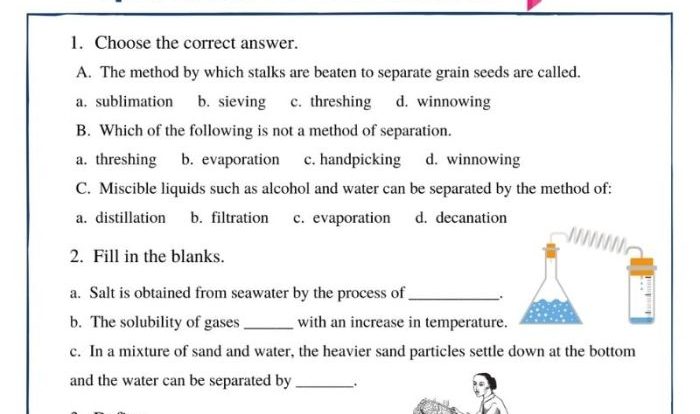Introducing the Molecular Compounds Worksheet Answer Key, an invaluable resource that unlocks the mysteries of chemical compounds. This comprehensive guide empowers learners with the knowledge to identify, classify, and comprehend the properties and reactions of these essential building blocks of matter.
Delving into the intricacies of molecular compounds, we embark on a journey that explores their diverse types, naming conventions, and physical characteristics. We uncover the fundamental principles governing their reactivity and delve into their myriad applications that shape our everyday lives.
Types of Molecular Compounds
Molecular compounds are formed when two or more non-metal atoms share electrons. They are classified into three main types: covalent, polar covalent, and ionic.
Covalent Compounds
- Formed by the sharing of electrons between atoms of the same element.
- Examples: H 2, O 2, N 2, CH 4.
- Properties: Generally non-polar, have low melting and boiling points, and are poor conductors of electricity.
Polar Covalent Compounds
- Formed by the sharing of electrons between atoms of different elements.
- Examples: HCl, NH 3, H 2O.
- Properties: Have a slight polarity due to the unequal sharing of electrons, have higher melting and boiling points than covalent compounds, and are weak conductors of electricity.
Ionic Compounds
- Formed by the transfer of electrons from one atom to another.
- Examples: NaCl, KCl, CaO.
- Properties: Have a strong polarity, have high melting and boiling points, and are good conductors of electricity in the molten or dissolved state.
Nomenclature of Molecular Compounds: Molecular Compounds Worksheet Answer Key
Molecular compounds are named using a system that indicates the number and type of atoms present in the molecule.
Rules for Naming Covalent Compounds
- The first element is named first, followed by the second element with the suffix “-ide”.
- Prefixes are used to indicate the number of atoms of each element.
- Examples: CH 4– methane, N 2O – dinitrogen monoxide, CCl 4– carbon tetrachloride.
Rules for Naming Polar Covalent Compounds
- The first element is named first, followed by the second element with the suffix “-ide”.
- The prefixes “mono-” and “di-” are used to indicate the number of atoms of each element.
- Examples: HCl – hydrogen chloride, NH 3– ammonia, H 2O – water.
Importance of Correct Nomenclature
- Ensures clear and unambiguous communication about chemical substances.
- Helps in predicting the properties and reactivity of compounds.
- Facilitates the organization and retrieval of chemical information.
Properties of Molecular Compounds
The properties of molecular compounds depend on their structure, polarity, and intermolecular forces.
Physical Properties
- Melting point and boiling point:Generally low due to weak intermolecular forces.
- Solubility:Polar molecular compounds are soluble in polar solvents, while non-polar molecular compounds are soluble in non-polar solvents.
Relationship between Molecular Structure and Properties
- Polarity affects solubility and intermolecular forces.
- Shape and size affect melting point and boiling point.
Applications of Molecular Compounds
- Fuels:Hydrocarbons are used as fuels in cars and other vehicles.
- Pharmaceuticals:Many drugs are molecular compounds.
- Solvents:Polar molecular compounds, such as water and ethanol, are used as solvents.
Reactions of Molecular Compounds

Molecular compounds can undergo various types of reactions, including:
Types of Reactions, Molecular compounds worksheet answer key
- Combustion:Reaction with oxygen, releasing heat and light.
- Substitution:Replacement of one atom or group with another.
- Addition:Addition of an atom or group to a molecule.
Factors Affecting Reactivity
- Polarity
- Bond strength
- Molecular structure
Applications of Molecular Compounds
Molecular compounds have a wide range of applications in everyday life and industry.
Everyday Applications
- Food:Many food additives and flavors are molecular compounds.
- Cleaning products:Detergents and soaps are molecular compounds.
- Personal care products:Cosmetics and fragrances are molecular compounds.
Industrial Applications
- Plastics:Polyethylene and polypropylene are used in packaging and construction.
- Pharmaceuticals:Many drugs are molecular compounds.
- Fuels:Hydrocarbons are used as fuels in cars and other vehicles.
Potential Benefits and Risks
- Benefits:Improved quality of life, technological advancements.
- Risks:Environmental pollution, health hazards.
Question Bank
What is the importance of naming molecular compounds correctly?
Correct nomenclature ensures clear and unambiguous communication among chemists, facilitating accurate identification, classification, and understanding of molecular compounds.
How do molecular compounds differ from ionic compounds?
Molecular compounds are formed by the covalent bonding of atoms, while ionic compounds result from the electrostatic attraction between positively and negatively charged ions.
What factors influence the reactivity of molecular compounds?
Factors such as molecular structure, bond strength, and the presence of functional groups significantly impact the reactivity of molecular compounds.

